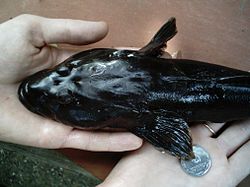
The round goby is a fish. Defined as a euryhaline bottom-dwelling goby of the family Gobiidae, it is native to Central Eurasia, including the Black Sea and the Caspian Sea. Round gobies have established large non-native populations in the Baltic Sea, several major Eurasian rivers, and the North American Great Lakes.

The sand goby, also known as a polewig or pollybait, is a species of ray-finned fish native to marine and brackish waters European waters from the Baltic Sea through the Mediterranean Sea and into the Black Sea where it occurs in sandy or muddy areas of inshore waters at depths of from 4 to 200 metres. This species can reach a length of 11 centimetres (4.3 in) TL. This species is sometimes kept in public aquariums. The sand goby is of a sandy colour, with darker markings on the sides and a creamy-white underside. In the breeding season the male fish has blue spot at the rear of the first dorsal fin, ringed with white. The fish has a slender body, and the head is about a quarter of the total length.

The black goby is a species of ray-finned fish found in the Eastern Atlantic and Mediterranean Sea and Black Sea. It inhabits estuaries, lagoons, and inshore water over seagrass and algae. It feeds on a variety of invertebrates and sometimes small fish. This species can also be found in the aquarium trade.
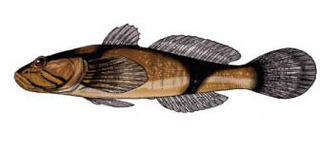
Benthophiloides brauneri is a species of goby, a benthophilic fish native to the fresh and brackish waters of the Black Sea, the Caspian Sea and the Sea of Azov as well as their surrounding rivers and estuaries. Despite the wide distribution, very few observations overall of this fish exist, and just one from the Caspian basin. It has been found in still waters at depths down to around 15 metres (49 ft). Males of this species can reach a length of 7.2 centimetres (2.8 in) SL while females only reach 5.1 centimetres (2.0 in) SL. This fish only lives for one year.

Knipowitschia caucasica, the Caucasian dwarf goby, is a species of goby native to marine, fresh and brackish waters along the coasts of the Black Sea, the Sea of Azov, the Caspian Sea and the Aegean Sea and to the Haliacmon drainage of Greece. It inhabits shallow waters with plentiful weed growth where it can find its prey consisting of small crustaceans, the larvae of chironomids and the larvae of the mussel Dreissena polymorpha. Spawning takes place after their first winter with the eggs being deposited onto the roof of a cavity formed by rocks, shells or plant materials. The male will remain to defend the eggs. This species can reach a length of 5 centimetres (2.0 in) TL
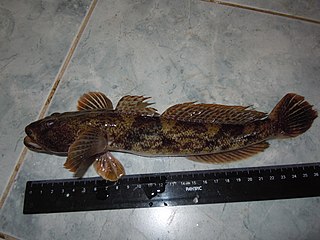
Mesogobius is one of the genera of benthophiline gobiid fishes native to the basins of the Black and Caspian Seas.
Favonigobius melanobranchus, the blackthroat goby, is a species of goby native to the Indian Ocean and the western Pacific Ocean as well as being recorded in the Mediterranean Sea. This fish is found on sandy bottoms and seagrass beds at depths of from 0 to 5 metres. It can reach a length of 5.5 centimetres (2.2 in) TL.

Hector's goby is a species of goby native to the Indian Ocean to the islands of Micronesia in the western Pacific Ocean. It can be found on sheltered coral reefs at depths of from 3 to 30 metres. This species reaches a length of 8.5 centimetres (3.3 in) SL. It can also be found in the aquarium trade. The specific name honours Gordon Hector who was Chief Secretary to the Government of the Seychelles, in gratitude for his help to Smith's work in the Seychelles.

Fries's goby is a species of goby native to the Eastern Atlantic Ocean along the coasts of Europe and northern Africa as well as the Mediterranean Sea to the Sea of Marmara. This species burrows into muddy or muddy sand substrates at depths of from 10 to 130 metres and is frequently found in association with the Norway lobster Nephrops norvegicus. This species can reach a length of 13 centimetres (5.1 in) TL. The specific name honours the Swedish zoologist Bengt Fredrik Fries (1799-1839).

The stellate tadpole-goby is a species of gobiid fish native to the basin of the Sea of Azov where it occurs in the Gulf of Taganrog and limans of the eastern coast. It also lives in the lower Don River up to the Tsimlyansk Reservoir. It occurs in fresh and brackish waters of depths greater than 3 metres (9.8 ft), preferring shallow coastal lagoons and lowland rivers. Males can reach a length of 13.5 centimetres (5.3 in) TL while females only reach 11 centimetres (4.3 in) TL.

Pinchuk's goby is a species of goby native to the Black Sea and the Sea of Azov.

The Caspian tadpole goby is a species of goby which is widespread in the basin of the Caspian Sea, specifically in the near-estuary zone of the rivers and in small bays. It is a common species in the Volga River delta near Astrakhan, occurred in the deltas of rivers Terek, Ural, Samur. During the warmer months, this species prefers to live at depths of from .5 to 10 metres, moving in the colder months to depths of 20 to 25 metres. It can reach a length of 11.6 centimetres (4.6 in) TL.

The red-mouthed goby is a species of goby native to the Eastern Atlantic Ocean from southwestern Ireland to the coasts of Morocco and Senegal, and also in the Mediterranean Sea where it occurs in inshore waters at depths of from 15 to 40 metres in areas with rocky or sandy substrates or in meadows of sea-grass. This species can reach a length of 18 centimetres (7.1 in) TL. It may also be found in the aquarium trade.

The small-spine tadpole-goby is a species of goby, a small fish native to the eastern coasts of the Caspian Sea and the lower reaches of the Volga River up to Volgograd. In the sea it is recorded from the Cape Peschany to the Çeleken Peninsula and Ogurja Ada Island in the south. It is abundant the Volga River delta. This species can be found at depths down to 50 metres (160 ft) although the adults generally are not found deeper than 11 metres (36 ft). This species can reach a length of 6.6 centimetres (2.6 in) TL. The specific name honours the Azerbaijani ichthyologist A. A. Mahmudbekov, studied the fish of the Caspian Sea for much of his life.

Mesogobius nonultimus, or the Caspian toad goby, is one of the species of gobiid fish endemic to the brackish-waters Caspian Sea (lake). It will grow up to a length of 17.4 cm.

The striped goby is a species of goby native to the Mediterranean Sea where it occurs on coralline grounds at depths of from 15 to 85 metres though normally not deeper than 50 metres (160 ft). This species can reach a length of 5.8 centimetres (2.3 in) SL. This species can also be found in the aquarium trade.
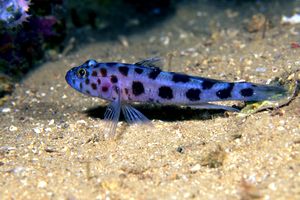
Thorogobius ephippiatus, the leopard-spotted goby, is a species of goby native to the eastern Atlantic Ocean and the Mediterranean Sea.
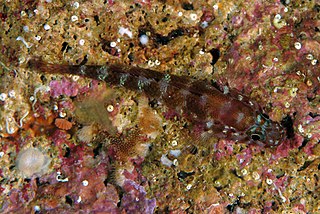
Steinitz's goby is a species of goby. It is native to the Mediterranean Sea near Marseilles. It has been recently recorded in the Adriatic Sea in Croatia, Tyrrhenian Sea in Italy, and in the Black Sea in Ukraine. This species can be found in underwater grottoes in inshore waters at depths of 2 to 15 metres. Steinitz's goby can reach a length of 3.8 centimetres (1.5 in) SL. Its name honours the marine biologist and herpetologist Heinz Steinitz (1909-1971) of the Hebrew University, Jerusalem.
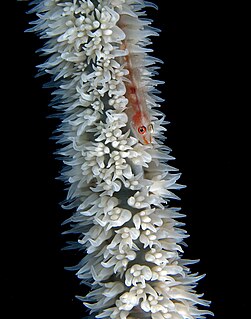
Bryaninops yongei, the wire-coral goby or whip coral goby, is a benthic species of goby widely distributed from the tropical and subtropical waters of the Indian Ocean to the islands in the center of the Pacific Ocean.

The largetooth goby, also known as Wilbur's goby, is a species of ray-finned fish from the family Gobiidae which is native to the Indo-Pacific from the Seychelles to Micronesia. Its known range has been extended to the Red Sea as specimens were photographed at one site and collected at another site off Egypt. This species lives in sheltered marine waters at depths of from 0 to 20 metres preferring areas with sandy substrates. This species grows to a length of 6.5 centimetres (2.6 in) SL. This species is the only known member of its genus. This species is not obviously sexually dimorphic and it has a background colour of pale brown to greenish-brown and a pale ventral side. The body is marked with brown and white spots, pairs of larger brown spots create a mid-lateral row along its flanks and there is a dark spot on the caudal fin peduncle. It has a brown blotch on the cheek and a series of short brown bars along its back. The largetooth goby is a solitary fish which is found in coastal bays, lagoons and estuaries over fine sandy substrates close to the margins of reefs or silt beds in the vicinity of sheltered and often turbid coastal reefs. It is most frequently collected from shallow waters to 7 metres (23 ft), around coral reefs but off southern Japan, the largetooth goby occurs at the bottom of sandy bays. The specific name honours the American physician, Ray Lyman Wilbur (1875–1949) who was president of Stanford University from 1916–1943, as well as being the United States Secretary of the Interior from 1929–1933. Wilbur helped the author, Herre, get to Palau, the type locality of this species.

